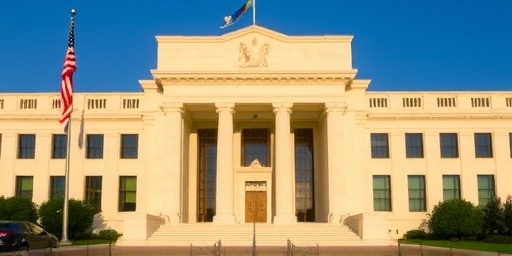In a pivotal shift for the U.S. economy, the Federal Reserve‘s latest meeting minutes indicate a strong inclination toward a rate cut as early as next month. Released on Wednesday, the document from the November Federal Open Market Committee (FOMC) session reveals that a majority of policymakers now see a compelling case for lowering interest rates in December, driven by persistent cooling in inflation metrics. This dovish signal has ignited optimism across financial markets, with stock indices surging and bond yields dipping in response.
The anticipation stems from recent economic data showing inflation edging closer to the Fed’s long-standing 2% target. Core PCE inflation, the central bank’s preferred gauge, rose just 2.6% year-over-year in October, down from peaks above 7% in 2022. Officials noted that while progress remains uneven, the trajectory supports easing monetary policy to prevent an unnecessary economic slowdown. Chair Jerome Powell, in recent speeches, has emphasized a data-dependent approach, but the minutes underscore growing consensus for action.
Fed Minutes Expose Internal Debate on Rate Cut Timing
The Federal Reserve‘s minutes, covering deliberations from the November 6-7 meeting, paint a picture of evolving sentiment among the 19 FOMC participants. A ‘couple’ of members advocated for no rate cut at all this year, citing lingering inflationary pressures in sectors like housing and services. However, the majority expressed support for a 25-basis-point reduction in December, viewing it as a measured step to sustain labor market strength without reigniting price pressures.
Key excerpts highlight the nuanced discussion: ‘Most participants assessed that the current stance of monetary policy was restrictive and favored a reduction in the target range for the federal funds rate at the December meeting,’ the minutes state. This marks a departure from the more hawkish tone of earlier 2024 meetings, where rate cuts were projected but not urgently endorsed. Economists point to weakening job growth—nonfarm payrolls increased by only 12,000 in October, the weakest since 2020—as a catalyst for this pivot.
Historical context adds weight to these signals. The federal funds rate has held steady at 4.75%-5% since July, following a series of hikes totaling 525 basis points from March 2022 to combat post-pandemic inflation. Now, with the benchmark rate well above neutral estimates of 2.5%-3%, the Fed appears ready to unwind some tightening. Analysts from Goldman Sachs noted in a post-release report, ‘The minutes confirm our view of a December rate cut, with risks tilted toward further easing in 2025 if data softens further.’
Cooling Inflation Data Bolsters Case for Federal Reserve Action
At the heart of the Federal Reserve’s potential rate cut decision lies the ongoing battle against inflation. The Consumer Price Index (CPI) for October showed a 2.6% annual increase, with core CPI excluding food and energy at 3.3%—the lowest since April 2021. These figures, combined with producer price data indicating subdued wholesale inflation, suggest the disinflationary process is gaining traction.
The Fed’s 2% target, rooted in price stability goals, has been elusive amid supply chain disruptions and fiscal stimulus effects from the COVID-19 era. Yet, recent trends are encouraging: shelter costs, a stubborn component, rose at the slowest pace in four years, while energy prices stabilized. Fed Governor Lisa Cook remarked during a panel discussion last week, ‘Inflation is moving sustainably toward our target, allowing us to consider supportive policy adjustments.’
Broader economic indicators reinforce this narrative. GDP growth for Q3 clocked in at 2.8% annualized, but consumer spending slowed to 2.4%, hinting at fatigue from high interest rates. The unemployment rate ticked up to 4.1%, still low historically but signaling cooling demand. These dynamics have prompted the Federal Reserve to recalibrate, with projections from the September dot plot indicating two more cuts by year-end if inflation continues its descent.
Experts caution that risks persist. Geopolitical tensions in the Middle East could spike oil prices, potentially derailing progress. Nonetheless, the minutes reflect confidence: ‘Participants generally saw inflation as having eased substantially,’ providing a green light for interest rate relief.
Markets Rally on Dovish Federal Reserve Outlook
Financial markets wasted no time reacting to the Federal Reserve’s signaled rate cut. The S&P 500 climbed 1.2% on the day of the minutes’ release, erasing recent losses and pushing toward record highs. The Dow Jones Industrial Average gained 450 points, while the Nasdaq Composite surged 1.5%, led by tech giants sensitive to borrowing costs.
Bond markets echoed the enthusiasm, with the 10-year Treasury yield falling to 4.32%, its lowest in weeks. This decline eases mortgage and corporate borrowing rates, benefiting sectors from real estate to manufacturing. Investors poured into rate-sensitive assets; mortgage applications jumped 7% in the week following similar Fed hints, per the Mortgage Bankers Association.
The rally extends beyond equities. The U.S. dollar weakened against major currencies, boosting exports, while gold prices rose as a hedge against potential policy shifts. Market-implied probabilities, via Fed funds futures, now price in a 75% chance of a December rate cut, up from 60% pre-minutes. BlackRock’s chief investment strategist, Rick Rieder, commented, ‘This dovish tilt from the Fed is a shot in the arm for risk assets, fostering confidence that a soft landing is achievable.’
However, not all reactions are uniform. Small-cap stocks, via the Russell 2000, outperformed with a 2% gain, as lower interest rates disproportionately aid smaller firms with higher debt loads. Conversely, bank stocks dipped slightly, reflecting compressed net interest margins. Overall, the market’s response underscores heightened investor confidence in the Federal Reserve’s navigation of interest rates and inflation.
Implications of Rate Cut for Households and Businesses
A Federal Reserve rate cut in December could ripple through the economy, offering relief to millions of Americans grappling with elevated borrowing costs. For households, adjustable-rate mortgages and credit card debt—averaging 21% APR—stand to benefit most immediately. The average 30-year fixed mortgage rate, hovering near 6.8%, could dip below 6.5% within months, potentially unlocking pent-up homebuying demand.
Businesses, particularly in capital-intensive industries like autos and construction, would see cheaper financing for expansions. Auto loan rates, above 7% for new vehicles, might ease, stimulating sales that have lagged amid high prices. The National Association of Home Builders estimates that a 50-basis-point cut cycle could add 100,000 housing starts annually.
Yet, benefits aren’t guaranteed for all. Savers and retirees reliant on high-yield CDs and bonds may face lower returns, squeezing fixed incomes. Inflation, though cooling, remains above target, so any rate cut must avoid premature easing that could prolong price pressures. Economists at JPMorgan forecast that a December move would lower the fed funds rate to 4.5%-4.75%, with two more quarter-point cuts in 2025, aiming for a terminal rate around 3.75%.
Wage growth, at 4% year-over-year, continues to outpace inflation, supporting consumer spending. But with corporate debt at $13 trillion, lower interest rates could avert defaults in vulnerable sectors like commercial real estate, where office vacancies exceed 20% in major cities.
Globally, the U.S. pivot influences trading partners. The European Central Bank, facing similar inflation woes, may follow suit, while emerging markets gain from a softer dollar. Fed policy remains a linchpin for international finance.
Looking Ahead: Federal Reserve’s Path Through 2025
As the December FOMC meeting approaches on December 17-18, all eyes will be on incoming data to confirm the Federal Reserve’s rate cut trajectory. Key releases include November’s jobs report on December 6 and CPI data on December 11, which could solidify or temper expectations. If unemployment rises above 4.2% or inflation surprises higher, the cut might be deferred—but current momentum favors easing.
Beyond next month, the Fed’s 2025 outlook hinges on sustained disinflation and balanced growth. Updated economic projections in December will refine the dot plot, potentially signaling three to four cuts next year. Powell has stressed vigilance against both recession risks and inflationary rebounds, positioning the central bank for gradual normalization.
For investors, this environment suggests rotating toward growth-oriented assets while monitoring policy cues. Policymakers’ forward guidance will be crucial, especially amid uncertainties like the incoming administration’s fiscal plans. A successful rate cut cycle could cement the soft landing narrative, fostering robust expansion without reigniting inflation. As the economy stands at this inflection point, the Federal Reserve’s decisions will shape interest rates, inflation dynamics, and prosperity for years to come.









